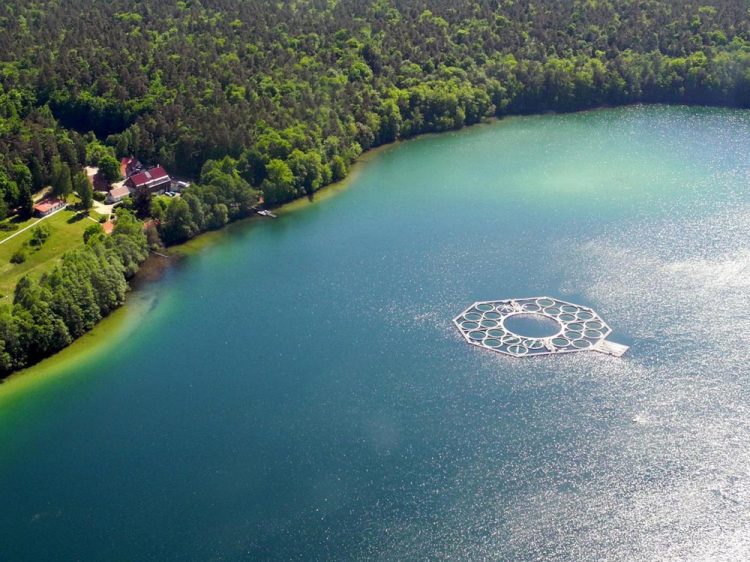Biological field stations: Keeping a pulse on our planet

The LakeLab at Lake Stechlin in Brandenburg, Germany is a biological field station operated by the Leibniz-Institute of Freshwater Ecology and Inland Fisheries where scientists are studying the effects of climate change on lakes. It consists of a large central enclosure and 24 enclosures of 9 metres diameter as experimental units. Credit: ©Peter Casper
A recent BioScience paper provides the first comprehensive inventory of the world's biological field stations. Its authors report 1,268 stations are operating in 120 countries — from the tropics to the tundra, monitoring terrestrial, freshwater, and marine ecosystems. Long-term data collected by biological field stations are essential for underpinning environmental research, assessing environmental policies, and advancing conservation goals.
Take the case of acid rain. Its discovery in North America was made possible by environmental data collected at a biological field station nestled in the White Mountains of New Hampshire. Hubbard Brook Experimental Forest is just one of the many biological field stations located around the globe that are keeping a pulse on the health of our planet.
Gene E. Likens, President Emeritus of the Cary Institute of Ecosystem Studies, is a coauthor on the paper, “Understanding complex environmental problems relies on biological field stations. Our acid rain work, which informed the 1990 Clean Air Act, was based on more than 26 years of long-term data. Biological field stations are a critical part of the global research infrastructure. Yet many are vulnerable to closure and need to do a better job of communicating their importance to decision makers, funders, and citizens.”
Biological field stations are under continuous risk of closure due to financial insecurity, lack of public support, and weak governance. Some 38% are tied administratively to colleges and universities, with the rest overseen by museums, government organizations, and not-for-profits. The author's urge the creation of a sustainable framework for biological field stations that recognizes their regional, national, and global importance. They also highlight a need to integrate with larger initiatives, such as the Global Lakes Environmental Observatory Network and the Intergovernmental Platform on Biodiversity and Ecosystem Services.
Klement Tockner, Director of the German Leibniz-Institute of Freshwater Ecology and Inland Fisheries and lead author on the study explains, “Biological field stations are essential to managing the rapid environmental change taking place globally. We need a sustainable vision to ensure their success — one that includes political support, increased public awareness, modernized cyber infrastructure, and improved data sharing. At the same time, we need to expand stations in areas that are underrepresented ecologically and geopolitically.”
Most biological field stations are located in pristine or remote areas, like the Tundra Ecosystem Research Station situated in Canada's Southern Arctic Ecozone. Far fewer are in urbanized areas, like the Ecological Rhine Station situated on a former ship in Cologne, Germany. There is a vital need to record more environmental data in human-dominated systems, such as cities, and in sensitive areas such as deserts, savannas, mountainous regions, and offshore locations.
Undergraduate and graduate training is another benefit provided by biological field stations. These 'living laboratories' play a key role in educating the next generation of environmental scientists, and offer collaborative, hands-on research opportunities.
Likens concludes, “Given the myriad of problems facing our forests, freshwaters, and oceans – networked, sustainable biological field stations are essential. The information they collect is relevant to addressing most of today's pressing environmental problems — from air and water pollution to the movement of invasive pests and pathogens. They deserve our strong support and protection.”
###
The database on biological field stations is integrated in the Freshwater Information Platform: http://atlas.
Publication:
Tydecks, L. et al. (2016): Biological Field Stations: A Global Infrastructure for Research, Education, and Public Engagement. BioScience, doi: 10.1093/biosci/biv174.
Gene E. Likens is president emeritus at the Cary Institute of Ecosystem Studies and a distinguished research professor at the University of Connecticut, Storrs; his research focuses on human impacts on aquatic and terrestrial ecosystems. Klement Tockner is director at the Leibniz-Institute of Freshwater Ecology and Inland Fisheries, Berlin and a professor of aquatic ecology at the Freie Universität Berlin, in Germany.
The Cary Institute of Ecosystem Studies is an independent, nonprofit environmental research organization located on 2,000 acres in New York's Hudson Valley. A world-premier center for ecosystem science, areas of expertise include disease ecology, forest and freshwater health, climate change, urban ecology, and invasive species. Since 1983, our scientists have produced the unbiased research needed to inform effective management and policy decisions. Our science program is complemented by education and outreach initiatives.
Media Contact
All latest news from the category: Life Sciences and Chemistry
Articles and reports from the Life Sciences and chemistry area deal with applied and basic research into modern biology, chemistry and human medicine.
Valuable information can be found on a range of life sciences fields including bacteriology, biochemistry, bionics, bioinformatics, biophysics, biotechnology, genetics, geobotany, human biology, marine biology, microbiology, molecular biology, cellular biology, zoology, bioinorganic chemistry, microchemistry and environmental chemistry.
Newest articles

First-of-its-kind study uses remote sensing to monitor plastic debris in rivers and lakes
Remote sensing creates a cost-effective solution to monitoring plastic pollution. A first-of-its-kind study from researchers at the University of Minnesota Twin Cities shows how remote sensing can help monitor and…

Laser-based artificial neuron mimics nerve cell functions at lightning speed
With a processing speed a billion times faster than nature, chip-based laser neuron could help advance AI tasks such as pattern recognition and sequence prediction. Researchers have developed a laser-based…

Optimising the processing of plastic waste
Just one look in the yellow bin reveals a colourful jumble of different types of plastic. However, the purer and more uniform plastic waste is, the easier it is to…



